
Waddesdon Manor is a country house in the village of Waddesdon, in Buckinghamshire, England. Owned by the National Trust and managed by the Rothschild Foundation, it is one of the National Trust's most visited properties, with over 463,000 visitors in 2019.

Wootton Fitzpaine is a village and civil parish in the county of Dorset in South West England. It lies approximately 3 miles (4.8 km) north-east of Lyme Regis in a small side valley of the River Char, close to the Marshwood Vale. The civil parish covers an area of 3,307 acres (1,338 ha) and includes the ecclesiastical parish and small settlement of Monkton Wyld to the west. In the 2011 census the civil parish had 180 dwellings, 134 households and a population of 345.

Dunham Massey is a civil parish in the Metropolitan Borough of Trafford, Greater Manchester, England. The parish includes the villages of Sinderland Green, Dunham Woodhouses and Dunham Town, along with Dunham Massey Hall and Park, formerly the home of the last Earl of Stamford and owned by the National Trust since 1976. Dunham Massey is in the historic county of Cheshire, but since 1974 has been part of Trafford Metropolitan Borough; the nearest town is Altrincham. At the 2001 census, the parish had a population of 475.

Berrynarbor is a village, civil parish and former manor in the North Devon district of Devon, England. According to the 2001 census the parish had a population of 749, increasing to 802 at the 2011 census. The village is located on the north coast of the county to the north of Exmoor, about three miles east of Ilfracombe. The parish is surrounded clockwise from the east by the parishes of Combe Martin, Kentisbury, East Down, Marwood, Bittadon, and Ilfracombe. Berrynarbor has within its purview to all sides a mixture of dense woodlands and farms and lies within the North Devon Area of Outstanding Natural Beauty.

Pennsbury Manor is the colonial estate of William Penn, founder and proprietor of the Colony of Pennsylvania, who lived there from 1699 to 1701. He left it and returned to England in 1701, where he died penniless in 1718. Following his departure and financial woes, the estate fell into numerous hands and disrepair. Since 1939 it has been the name of a reconstructed manor on the original property.

Wytham Abbey is a privately-owned Grade I listed historic manor house situated in the village of Wytham, 3 miles northwest of the centre of Oxford, England, near the River Thames.

Sawston Hall is a Grade I listed Tudor manor house in Sawston, Cambridgeshire dating from the 16th century. It has many fine features, such as the magnificent Great Hall complete with Elizabethan panelling and a large Tudor fireplace with fireback dated 1571. The house also has its own panelled private chapel which has an 18th-century decorated plaster ceiling and wonderful stained glass windows. On the first floor there is a long gallery and a bedroom where Queen Mary I is rumoured to have slept.

Trevarno is a private country estate in south-west Cornwall, England, UK, near the village of Crowntown, 2 miles (3.2 km) north-east of Helston. First developed in the 13th century, the estate was owned by a succession of families until 1994 when it was sold for development as a tourist attraction based around its extensive gardens. It was open to the public from 1998 until 2011, but the estate has since been broken up and the house and gardens are again a private residence.

Aydon Castle, previously sometimes called Aydon Hall, is a fortified manor house at Aydon near to the town of Corbridge, Northumberland, England. It is a Scheduled Ancient Monument, and is designated by English Heritage as a Grade I listed building.
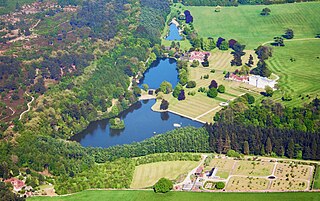
Witley Park, formerly known as Lea Park, is an estate dating from the late 19th century between Godalming and Haslemere in Surrey, England. Its landscaped grounds include three artificial lakes, one of which conceals an underwater conservatory and smoking room. The mansion house, rebuilt for the swindler Whitaker Wright, was gutted by fire in October 1952 and the ruins were demolished in January 1954. In the early 21st century, a new house was built on the site.
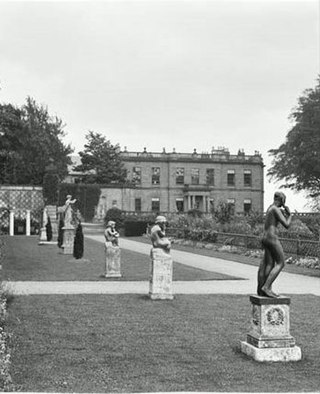
Windlestone Hall is a mid-16th century Elizabethan country house, heavily rebuilt in 1821 to form a Greek revival stately home, situated near Rushyford, County Durham, England. The Hall sits within 400 acres of designed parkland. It is a Grade II* Listed building. As of 2022 it is back in private family ownership, with the surrounding estate maintained and conserved by a dedicated heritage charitable trust.

Reddish House, also known as Reddish Manor, is an early 18th-century manor house in the village of Broad Chalke in Wiltshire, England. It was possibly built in its current form for Jeremiah Cray, a clothier. It is a Grade II listed building.
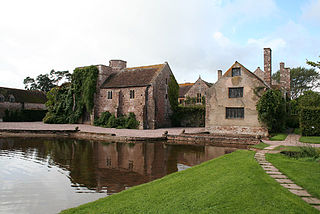
Cothay Manor is a grade one listed medieval house and gardens, in Stawley, near Wellington, Somerset. The manor grounds consist of almost 40 acres and include cottages, outbuildings, stables, and 12 acres of gardens.

Ruislip Woods is a Site of Special Scientific Interest and national nature reserve covering 726 acres (294 ha) in Ruislip in the London Borough of Hillingdon. The woods became London's first national nature reserve in May 1997. Ruislip Local Nature Reserve at TQ 090 899 is part of the national nature reserve.

Boughton Monchelsea Place, previously Boughton Court, is a 16th-century country house in Boughton Monchelsea, Kent, England. The first part of the house was built by Robert Rudston circa 1567–75 on the site of an earlier manor house. It has been modified a number of times during its history achieving its present form in 1819. It has been a home to a number of members of parliament for Maidstone or for Kent, including Sir Francis Barnham, Sir Robert Barnham (1646–85) Sir Barnham Rider (1698–1728) and Thomas Rider (1805–47).
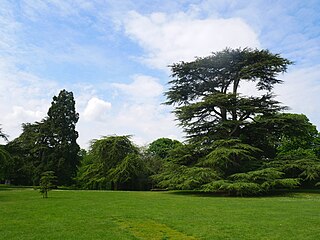
Boston Manor Park is a large public park in the London Borough of Hounslow. A combination of woodland and open space, with an area adjoining the Grand Union Canal, it was created in 1924 from part of the historic estate of the 17th-century stately home Boston Manor House.

Hackwood Park is a large country estate that primarily consists of an early 18th-century ornamental woodland and formal lawn garden and a large detached house. It is within the boundaries of Winslade, an overwhelmingly rural parish immediately south of Basingstoke in Hampshire. In its 260-acre (110 ha) grounds contain 23 separately listed structures including a teahouse pavilion, an ornamental bridge, statue of George I of Great Britain, three dispersed stone tōrōs, five urns and two fountains, a coach house and stables. Sheep and deer are tended to on grounds behind a variously arc-shaped and straight ha-ha wall.

Knoll Farm, also formerly known as McLaughlin Farm, is a historic farm property at 700 Bragg Hill Road in Fayston, Vermont. The farm has seen agricultural use since 1804, and the patterns of use are evident in the surviving farm buildings and landscape. The property, is still actively farmed and also used as a retreat center and is listed on the National Register of Historic Places in 1996.
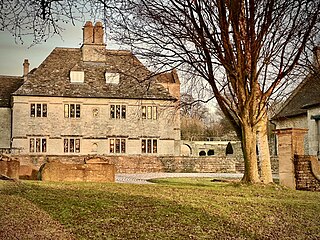
Rudloe Manor is a 17th-century Grade II* listed manor house in Box parish, Wiltshire, England.

Harlowbury, historically Herlaue Abbatis, was a medieval manor located in modern-day Harlow, Essex, England. The area's history dates back at least to the Iron Age, and a Roman villa is located not far from the site. The manor was adjacent to a now-deserted medieval village; both the villa and village are scheduled monuments. Harlowbury was first established as an estate under the Abbey of Bury St Edmunds in 1044. In 1539, the abbey dissolved and the lands were sold to private owners: first to the Addington family, in 1680 to the North family of the Earldom of Guilford, and finally in 1879 to John Perry-Watlington.




















